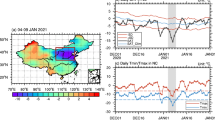Abstract
Using the NCEP/NCAR reanalysis data, the China rainfall data of the China Meteorological Administration, and the sea surface temperature (SST) data of NOAA from 1951–2000, the features of the anomalous longitudinal position of the subtropical high in the western Pacific (SHWP) in the pre-rainy season in South China and associated circulation and precipitation are studied. Furthermore, the relationship between SHWP and SST and the eastern Asian winter monsoon is also investigated. Associated with the anomalous longitudinal position of SHWP in the pre-rainy season in South China, the flow patterns in both the middle and lower latitudes are different. The circulation anomalies greatly influence the precipitation in the pre-rainy season in South China. When the SHWP is in a west position (WP), the South China quasi-stationary front is stronger with more abundant precipitation there. However, when the SHWP is in an east position (EP), a weaker front appears with a shortage of precipitation there. There exists a good relationship between the longitudinal position of SHWP and SST in the tropical region. A negative correlation can be found both in the central and eastern tropical Pacific and the Indian Ocean. This means that the higher (lower) SST there corresponds to a west (east) position of SHWP. This close relationship can be found even in the preceding autumn and winter. A positive correlation appears in the western and northern Pacific and large correlation coefficient values also occur in the preceding autumn and winter. A stronger eastern Asian winter monsoon will give rise to cooler SSTs in the Kuroshio and the South China Sea regions and it corresponds to negative SST anomaly (SSTA) in the central and eastern Pacific and positive SSTA in the western Pacific in winter and the following spring. The whole tropical SSTA pattern, that is, positive (negative) SSTA in the central and eastern Pacific and negative (positive) SSTA in the western Pacific, is favorable to the WP (EP) of SHWP.
Similar content being viewed by others
References
Chang, C.-P., Y. Zhang, and T. Li, 2000a: Interannual and interdecadal variations of the East Asian summer monsoon and tropical Pacific SSTs. Part I: Roles of the subtropical ridge.J. Climate,13(24), 4310–4325.
Chang, C.-P., Y. Zhang, and T. Li, 2000b: Interannual and interdecadal variations of the East Asian summer monsoon and tropical Pacific SSTs. Part II: Meridional structure of the monsoon.J. Climate,13(24), 4326–4340.
Chen Juan, 1999: The role of eastern Asian winter monsoon anomaly in interseasonal circulation connection and ENSO development. Ph.D. dissertation, Institute of Atmospheric Physics, Chinese Academy of Sciences, Beijing, 81pp. (in Chinese)
Chen Juan, and Sun Shuqing, 1999: Eastern Asian winter monsoon anomaly and variation of global circulation. Part II: Influence on SST by winter monsoon.Chinese J. Atmos. Sci.,23(3), 286–295. (in Chinese)
Deng Liping, and Wang Qianqian, 2002: On the relationship between precipitation anomalies in the first raining season (April–June) in southern China and SST over offshore waters in China.Journal of Tropical Meteorology,18(1), 45–55. (in Chinese)
Gao Bo, Chen Qianjin, and Ren Diandong, 1999: Diagnostic analysis on the severe drought/flood for the beginning of flood season in southern part of the south of Yangtze River Valley and northern South China.Quarterly Journal of Applied Meteorology,10(2), 219–226. (in Chinese)
Guo Qiyun, and Wang Qiqing, 1981: Analysis of summer monsoon precipitation during recent 30 years over China.Acta Geographic Sinica,36, 187–195. (in Chinese)
Lu, R., 2001: Interannual variability of the summertime North Pacific subtropical high and its relation to atmospheric convection over the warm pool.J. Meteor. Soc. Japan,79, 771–783.
Lu, R., and B. Dong, 2001: Westward extension of North Pacific subtropical high in summer.J. Meteor. Soc. Japan,79, 1229–1241.
Lu Riyu, 2002: Indices of the summertime western North Pacific subtropical high.Adv. Atmos. Sci.,19, 1004–1028.
Sun Shuqing, and Chen Juan, 2000: The variations of wind and thermodynamics fields in the South China Sea in summer during the anomaly winter monsoon.Climatic and Environmental Research,5(4), 400–416. (in Chinese)
Wu Shangsen, and Liang Jianyin, 1992: Temporal and spatial characteristics of the drought and flood during the rainy season in South China.Journal of Tropical Meteorology,8(1), 87–92. (in Chinese)
Yang Hui, and Sun Shuqing, 2003: Longitudinal displacement of subtropical high in the western Pacific in summer and its influence.Adv. Atmos. Sci.,20(6), 921–933.
Author information
Authors and Affiliations
Corresponding author
Rights and permissions
About this article
Cite this article
Hui, Y., Shuqing, S. The characteristics of longitudinal movement of the subtropical high in the western Pacific in the pre-rainy season in South China. Adv. Atmos. Sci. 22, 392–400 (2005). https://doi.org/10.1007/BF02918752
Received:
Revised:
Issue Date:
DOI: https://doi.org/10.1007/BF02918752




